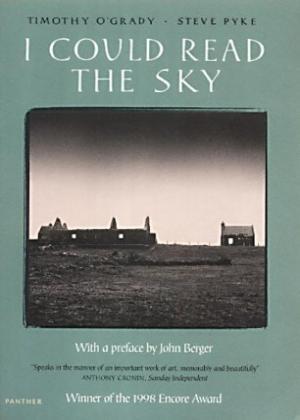The joy of browsing book shops tends to lead to serendipitous finds and recently I happened across I Could Read The Sky by Timothy O’Grady and Steve Pyke. Now, I tend to be wary of fiction authored by more than one person but, on picking it up, was relieved to find that it was a collaboration between an author and a photographer. It had also, as the cover proudly boasted, won the Encore Award back in 1998. After a quick flick through and a skim of the blurb I knew I wanted it. So I had it.
I Could Read The Sky is told by an Irish emigrant, tucked away in Kentish Town, living his twilight years. Like many before him, including his father, he left Ireland to come to England to make his fortune. But when he gets there the jobs never last and he finds himself chasing work across the land – in fields, in building sites – until he finally arrives in London. All he has is his accordion and his dreams of love to keep the loneliness at bay.
While the narrator tells us his story, the text is accompanied by a series of photographs by Steve Pyke. These range in subject from solemn landscapes to still lifes to portraits of lived-in faces. Their black and white nature encourages reflection, awards them gravitas. Although they are unrelated to the story, they follow the same path, telling of local life in rural Ireland before moving on to depict the lives of emigrants, capturing the loneliness that accompanies it. As the narrator says at the beginning, “I have sounds and pictures but they flit and crash before I can get them.” These pictures provide what he can’t find words to say.
(photos: © Steve Pyke)
O’Grady gives his narrator’s voice a light poetic touch, his skill for ventriloquism picking up Irish slang and grammatical nuances. It was for this that I was surprised to learn that O’Grady was American, although his time in Ireland will surely have trained his ear. And the other diaspora running through this novel are also painted with the subtlest of strokes:
The last time I saw Dan he was coming up from the quay with two lobster pots and the wind nearly blowing him back into the sea.
For the many Irish living in post-war England the work is manual and often dries up, forcing them to continually move around, their stories shared from Glasgow to London. Our narrator’s first job on landing in Liverpool is working in a potato field:
It’s November and coming out from under the covers in the morning is like entering the cold sea, but the work is so fierce that we have our shirts off by mid-morning. The field is all mud. There’s mud on my trousers, mud on the sack and mud up my arms. There’s mud gone down into my boots. If I hold a potato in my hand I can make no sense of it. I try to think of a piece of it buttered and salted at the end of a fork. But I can’t.
As life moves on he finds himself in London, just another nameless man responsible for building up the city:
There are bricks from all the years that make up the walls. When I pass them I try to think of the men who put them there. Who told them where to place the bricks? What way did they shave? What was the drink they liked the best? I fall in among them and among the ages of the city.
While I Could Read The Sky follows the story of one exile, doing for the Irish what Sam Selvon‘s The Lonely Londoners did for West Indians, it is the story of many emigrants the world over. A snapshot of the lonely, of what it means to be away from all that you love. It aches with experience: of growing up, of grief, of love, of death.
The collaboration between O’Grady and Pyke – echoing that of James Agee and Walker Evans in Let Us Now Praise Famous Men – ensures a work of art that accurately captures the exile’s experience through prose and photography. It’s a slim volume but that’s only because each picture is ample replacement for a thousand words. And while our narrator could read the sky, I’m certain to read this again.


A friend of mine used to go on about this book. Should have listened to him.
Your friend was in the know. I’m now curious to see the film, even if the average rating is 5.3/10.
Damn – it seems my feed alert failed to tell me you had updated, but thankfully I followed your comment from the Asylum!
So glad I did – I have never encountered anyone else who knows of this book. I found a battered hardback in a library sell off a few years ago, and found it utterly mesmerising. The union of pictures and words work so well. I felt I could stare at the images and get stories from them as well as from the text. One of my favourite pictures is the one of the dark haired woman in front of the floral wallpaper.
I have very limited book storage space, only a handful of chosen volumes get to stay once read – this has a place in those hallowed halls!